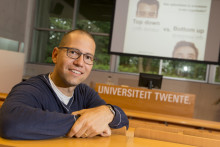Hans still has an engineer’s perspective on healthcare. Roughly fifteen years ago, he made the switch to the healthcare sector, although he has a background in mathematics and industrial engineering & management. ‘I had intended to stay at the university for a few years after acquiring my doctoral degree – until a decisive moment changed everything. A friend introduced me to an operation room manager, who invited me to apply my knowledge of logistics to the healthcare sector. I was shocked at how inefficient the planning was.’
The operation schedule often ran long, because surgeries took an average of forty minutes longer than planned. Hans learned that the estimate of the duration of an operation was based on the time that the surgeon was present. ‘They did not account for the preparation before and the clean-up after the operation. I was baffled to learn that they did not use the historical duration of an operation, which is after all the first step of logistical improvement. Planning with historical averages resulted in spectacular improvements: less overtime, fewer cancelled operations, shorter waiting times. That was fifteen years ago, but many hospitals still have not implemented these methods.’
Stone Age
It is not Hans’ intention to criticise the quality of the Dutch healthcare sector. ‘It is one of the best in the world.’ However, when it comes to planning and logistics, the sector is still stuck in ‘the Stone Age’ and running far behind the industrial sector. Together with the Operations Management in Healthcare department, the professor is working to improve the situation as part of the Centre for Healthcare Operations Improvement & Research (CHOIR) research group. ‘There are two sides to this improvement. We want to make healthcare more efficient and therefore cheaper, but also more effective: patients receive better care and staff gets to work in a more pleasant working environment. Instead of “hurry up and wait”, they will have more insight into what is coming next.’
That is quite a challenge. ‘The healthcare sector is inherently risk-averse,’ Hans explains. ‘This makes the sector wary of organisational changes. As engineers, we have an entirely different mindset. We learn through experimentation: we build prototypes or models and keep at it until we get it right. That is why I always present computer simulations to people in the healthcare sector: you have to show them what the improvements will actually look like.’
Far-reaching specialisation
Changes have to be made to healthcare logistics, says Hans. ‘The number of options available to patients is growing, the quality of healthcare is improving and care is becoming increasingly personalised. However, that involves far-reaching specialisation. We see an increase in the number of service windows where patients have to go. Capacity, such as manpower and equipment, is being dedicated to specific care.’
More service windows, each with its own queue, mean longer waiting times. As more and more people need care, these waiting times grow exponentially. So, a balance must be found. ‘With our knowledge of mathematics and operations management, we can objectify choices. This lets you make responsible decisions, both for patients and for society as a whole.’
Islands
Another sore point is the islands policy that plagues the healthcare sector. Hospitals turned their departments into so-called result-responsible units. That problem will only grow in the years to come as healthcare becomes increasingly personalised – a field in which the UT is also active.
‘You will end up with more specialists and therefore more service windows,’ Hans continues. ‘There is an entire operation behind each service window. Let’s say a restaurant allows you to order a fully custom-made meal. Curly, thin, straight or long fries, peanut oil or sunflower oil, etcetera. Each ingredient needs its own specialist. That would make the food unaffordable.’
Taking steps
There is no one-size-fits-all solution for this problem, Hans says. ‘However, you can certainly take steps to bring yourself out of the Stone Age. Use data to make predictions: Take an integral look at your capacity, instead of dividing your hospital into myriad islands, each with its own rigid schedule. Start mapping out ways to fund the care you provide. At the moment, it is a confusing mess. The stated costs of treatments are unreasonable. Healthcare insurance providers make their choices based on these costs. It is an irrational process.’
These logistical changes designed to keep healthcare affordable cannot come from a single source, Hans states. ‘It will require input from mathematicians, technical business administrators and financial experts. The social sciences must also be involved: it is partly about behavioural changes and accepting new technologies and working methods. It is clear that something must be done. The problem is that it is really difficult to make my area of expertise seem sexy. The first things to come to people’s minds are reorganisations and costly consultants who will come in to upset the status quo. That is exactly what we do not want. Our goal is to make the healthcare sector healthy – for patients and employees.’
This article appeared in our latest Science & Technology Magazine.






